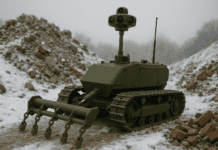This post is also available in:
 עברית (Hebrew)
עברית (Hebrew)
Collisions between planes and drones have steadily risen in recent years; it has been reported that there are about 100 cases a month where drones fly too close in range within planes. It has been found that drone collisions can be a major threat and can cause a substantial amount of damage.
It is not known how serious and dangerous these collisions can be since there is no legitimate standard test procedure for collision with drones. There currently are however, bird-strike tests for aircrafts to understand the tolerance of how severe these collisions could be to aircrafts. The difference between a drone and a bird is significant, considering the weight and the way they behave. For this reason, it is crucial to create a drone collision test because the collision results between a drone and bird could be dramatic.
Fortunately, the Fraunhofer Institute for High-Speed Dynamics, Ernst-Mach-Institut, in Germany is developing a way to test and interpret how consequential these collisions really can be.
Researchers used thick aluminum plates to model an airplane’s motor and discharged a drone battery at precise speeds using compressed air to demonstrate an accurate representation.
The results led to both the drone battery and motor getting fully destroyed. The whole point of this demonstration is to see what it takes for an airplane to counter these collision effects.
Researchers will keep utilizing different aircraft components until they can find out what it takes to completely resist these collisions between drones, according to uasvision.com.
Researchers are preparing to test even more realistic collision scenarios at higher speeds and larger weights. This will consist of speeds up to 150 meters per second with a maximum weight of three kilograms. This will help them understand how destructive drone related collisions can really be to airplanes. Tests like these have never been conducted before, but it should only lead to researchers grasping how damaging these collisions could be and what they should do in order to take the most appropriate precautions.


























